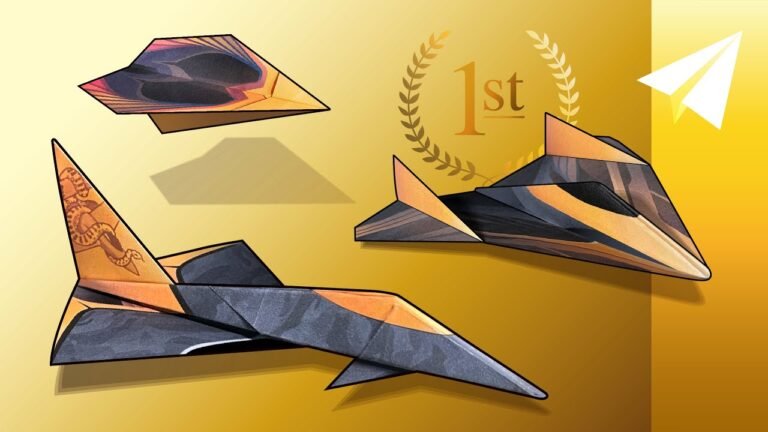
Are you ready to take your paper airplane skills to the next level? Whether you’re a seasoned competitor or a novice looking to improve your game, these top tips for dominating the paper airplane competition circuit are sure to elevate your folding and flying abilities. From choosing the right paper to perfecting your throwing technique, we’ve got you covered with expert advice that will have you soaring above the competition in no time. Let’s get ready to fold, aim, and fly!
- Choose the right paper: The type of paper you use can greatly affect the flight of your paper airplane. Opt for lightweight and sturdy paper, such as standard printer paper or origami paper.
- Focus on the design: Experiment with different paper airplane designs to find one that works best for you. Factors like wing shape, size, and overall aerodynamics can impact how far and straight your plane will fly.
- Practice makes perfect: Take the time to practice folding and throwing your paper airplane before the competition. Adjust your technique as needed to improve your throws and aim for greater distance and accuracy.
How can one go about judging a paper airplane contest?
When judging a paper airplane contest, there are two key factors to consider in determining the winner. First, the distance the plane travels from the starting line to where it comes to rest will be measured, even if the plane skids along the ground. Secondly, the hang time of the plane, or how long it stays airborne, will also be a crucial factor in determining the contest’s winner. By taking into account both distance and hang time, a fair judgment can be made to reward the creator of the best-performing paper airplane.
What are the rules for the paper airplane contest?
Get ready to soar to new heights in our paper airplane contest! To ensure fair competition, there are a few rules that must be followed. First and foremost, the plane must be launched by one person throwing it unaided from behind a straight launch line marked on the floor. This ensures that each participant starts from the same point and has an equal chance at success.
Attention all aspiring aviators! Keep in mind that passing over the launch line will result in disqualification. It’s crucial to have a steady hand and precise aim when releasing your paper airplane into the air. Additionally, touching the launch line or any point beyond during the launch is considered an invalid attempt. So make sure to practice your technique and aim for a flawless flight during the contest.
Ready, set, fold! Remember to follow the rules of the paper airplane contest for a chance to be crowned the ultimate paper pilot. Launch your plane from behind the designated line, avoid crossing over it, and ensure a clean takeoff to maximize your chances of success. With skill and precision, you could be the one to watch your paper creation soar to victory in this thrilling competition.
Can weight assist in the flight of a paper airplane?
Weight does not necessarily help a paper airplane fly. In fact, the lighter a paper airplane is, the easier it is for it to stay in the air for a longer period of time. When a paper airplane is lighter, it requires less force to keep it airborne, resulting in smoother and straighter flights.
By reducing the weight of a paper airplane, you can increase its lift and decrease drag. This allows the paper airplane to glide more efficiently through the air, making it fly farther and more gracefully. Adding weight to a paper airplane can disrupt its balance and stability, causing it to crash or veer off course.
In conclusion, weight does not play a positive role in helping a paper airplane fly. Keeping the paper airplane light and well-balanced is key to achieving longer and smoother flights. By understanding the principles of aerodynamics, you can create paper airplanes that soar through the air with ease.
Soar to Victory: Expert Strategies for Paper Airplane Competitions
Are you ready to take your paper airplane game to the next level? Look no further than these expert strategies for dominating paper airplane competitions. With a few simple tweaks and adjustments, you can soar to victory and outshine the competition.
First, focus on perfecting your folding technique. The way you fold your paper airplane can make a huge difference in its flight performance. Experiment with different folds and designs to find the one that gives you the best combination of distance and accuracy. Remember, practice makes perfect, so don’t be afraid to try out different techniques until you find the one that works best for you.
Next, consider the weight distribution of your paper airplane. Adding a paper clip or adjusting the way you fold the wings can help you achieve better balance and stability in flight. By carefully fine-tuning the weight distribution, you can ensure that your paper airplane flies straight and true, giving you a competitive edge in any competition. With these expert strategies in your arsenal, you’ll be well on your way to victory in paper airplane competitions.
Flight School: Mastering the Art of Paper Airplane Competitions
Are you ready to soar to new heights in the world of paper airplane competitions? Join us at Flight School, where you will learn the art of crafting and mastering paper airplanes. From precision folding techniques to aerodynamic principles, our expert instructors will guide you in creating the perfect paper aircraft to compete in thrilling challenges. Take flight with us and become a master in the exhilarating world of paper airplane competitions.
Mastering the art of paper airplane design and flight requires practice, patience, and attention to detail. By following these simple yet effective tips, you can improve your chances of success in any paper airplane competition. Remember to experiment with different designs, test your creations in various environments, and always strive for precision in your folds and throws. With dedication and determination, you can soar to new heights and achieve victory in the exciting world of paper airplane competitions.





